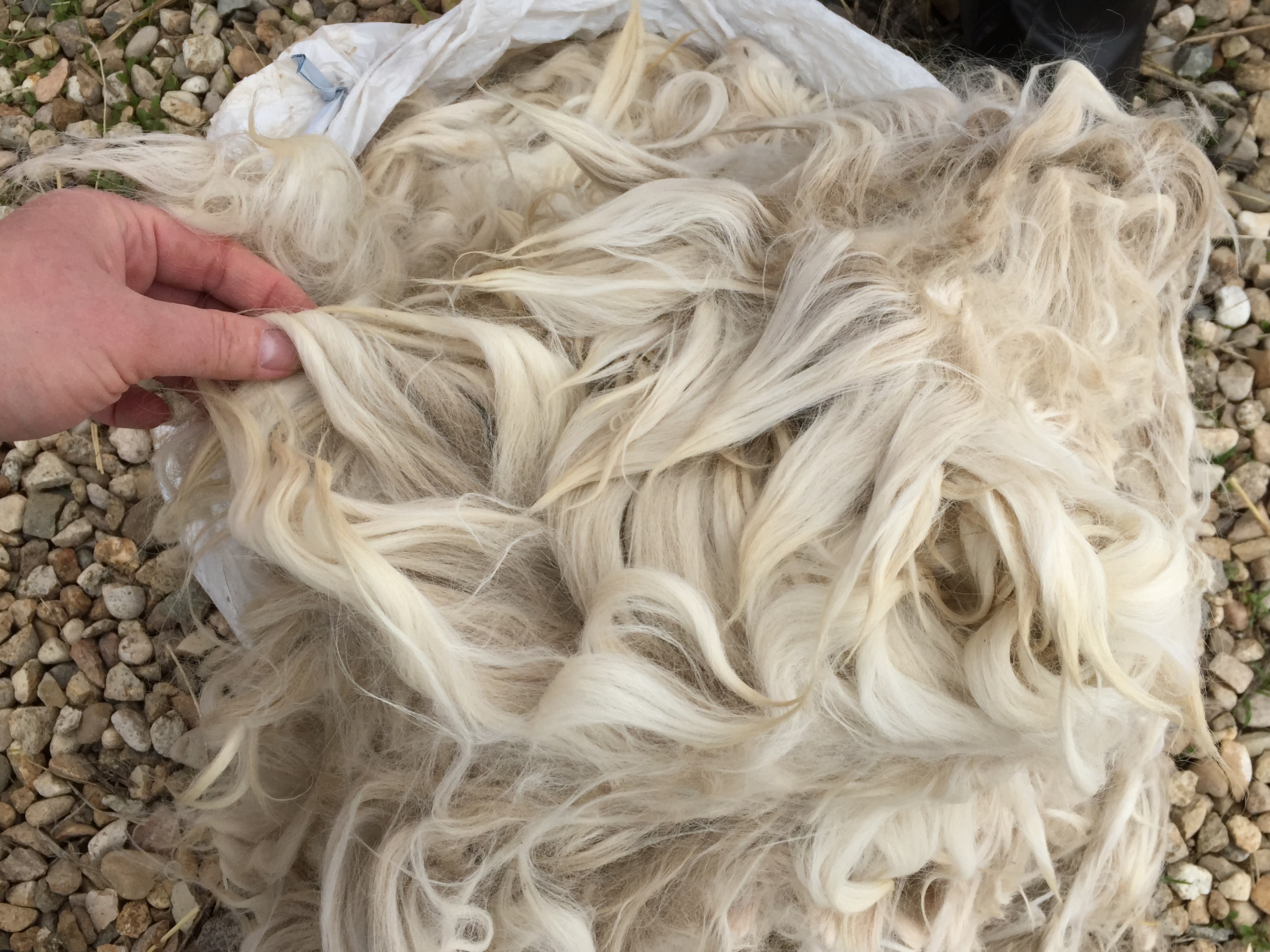Description
Each fleece is priced per OUNCE. When choosing quantity, choose how many ounces you want to buy. There are 16 ounces in a pound.
This listing is for the PRIME BLANKET CUT of Cloud’s fleece from Spring 2017.
Some of this fleece has been shipped already. Please note quantity in ounces when ordering.
Cloud : Male whethered Suri Alpaca. Age unknown, guessed to be about 7 years old. He is the herd guardian. He had super long locks, guessing 2 years worth of fleece on him this shearing. His fleece is heavy and dense and sliky soft. He had so much fur it would not all fit in one bag. The prime blanket fleece is separated from the seconds in two different bags. Fleece length of the prime cut is from 7 to 9 inches. This fleece is totally raw, unwashed, unprocessed, has not been skirted. Coco’s whole fleece weighs 11.5 pounds. The Prime fleece is 9.5 pounds, the seconds weigh 2 pounds.
The “seconds” from his fleece this cutting are nearly as long as some prime fleece shearings. They are still seconds and they are separated from the prime fleece in a separate bag (mainly because the whole fleece would not fit in a single bag, Cloud had so much silky fur!) but I think people will find that they are still quite useful.
NOTE: Cloud’s fleece was so popular I had 3 people offering to do 50/50 trade for it before I even finished getting it listed on the website! Suri Alpaca fleece is in very high demand!
Angora goats and alpacas do not have lanolin in their fleece like sheep have in their wool. People who are allergic to wool are usually safe with angora or alpaca products because they don’t have lanolin.
Additional Details about our herd:
We rescued 4 angora goats and 2 alpacas in November 2016. They had not been sheared that year. It was far too cold when we got them we did not shear them until Spring 2017. I’ve never done anything with any kind of fleece before. I had a lady that was going to teach me here but her health issues have been so bad she hasn’t been able to teach me. And I have had the worst Fibromyalgia symptoms I’ve ever had in my life so I haven’t been able to learn it on my own either. I’m going to have to shear them again in a couple of months and we have two babies from last spring that will be sheared this year too so we will have even more fleece! I hate to see these fleeces go to waste. I had wanted to turn the fiber into yarn that I could give to my Mom who crochets blankets, and to give some to a friend who makes hats for cancer patients at no cost to the patient, and for a couple friends who made chicken sweaters for me last year when my chickens were attacked in the winter and needed a cover until their feathers grew back. I’m willing to consider trades, such as halves where you keep half and send me half back as processed yarn. As it is I have raw unwashed fiber that no one knows what to do with it. Some of it may be matted and unuseable but most of it is still good. It has been stored in these plastic bags since the day they were sheared. None of the animals came with fleece blankets so they have been through the weather while they were on the animals. We have 4 adult angora goats and 2 yearlings, 1 huacaya alpaca, and 1 suri alpaca.
Each fleece is priced per OUNCE. (Originally I wanted to just sell whole fleeces but had more requests for partials than whole fleeces, so I’m willing to break it up to accomodate more wishes.) I am also willing to trade 50/50 for processed yarn if you pay shipping. Please contact me if you are interested in a fleece to yarn trade.
Note about alpacas:
Alpacas are in the Camelid family, along with llamas, vicuna, dromedaries and bactrian camels. While alpacas can spit like llamas and other camels, they really don’t spit very often, and usually at each other more than humans.
Huacaya alpacas make up approximately 90% of the alpaca population in the United States. Our huacaya alpaca is an intact male. Even though Coco and Cloud came from the same farm, he doesn’t get along very well with Cloud so he is kept in a separate field where he can see the herd but can not attack his rival. He goes into his stall in the barn when it rains because he does not like to be wet. Coco looks like a giant teddybear when he is in full coat. He doesn’t like to be petted though, unfortunately. Huacaya alpacas are the fluffy alpacas that look like giant teddy bears. Their fleece is very crimpy and fine.
Suri alpacas make up approximately 10% of the alpaca population in the United States. Cloud is a neutered male suri alpaca. He is the herd guardian. He is alert at all times, but very standoffish toward humans. He is very hard to catch at shearing time. He is sometimes mistaken for a llama (or a miniature llama) but he does NOT like it when people call him a llama! He knows what they are saying and he will flatten his ears at them. Suri alpacas look like miniature llamas. Their fleece is very silky and almost hairlike.



















